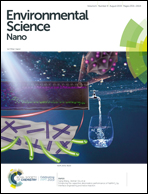Impact of ZnO nanoparticles on the antibiotic resistance genes (ARGs) in estuarine water: ARG variations and their association with the microbial community†
Abstract
Nanoparticles (NPs) promote the horizontal gene transfer (HGT) of plasmid-borne antibiotic resistance genes (ARGs) in pure bacterial culture, but the impact of NPs on ARG dissemination in the natural environment remains unknown. This study focused on the impact of ZnO NPs on the variation in ARGs and the association among ARGs, mobile genetic elements (MGEs) and microbial communities in an estuarine aquatic environment by taking the Yangtze Estuary as a representative area. The present study showed that the abundances of total ARGs increased after exposure to ZnO NPs, particularly at low doses (0.2 and 1 mg L−1). Relatively low and environmentally relevant concentrations of ZnO NPs likely induced the selection of sul1, tetA, ermB and qnrS, whereas a high concentration (10 mg L−1) of ZnO NPs was more selective for sul2 and tetW. After normalization of the abundances of ARGs exposed to NPs to those of the corresponding blanks, the ARGs in the DH samples with relatively high salinity and relatively low NP doses showed the highest normalized values by the end of the exposure period, which indicated the high dissemination potential of ARGs in relatively brackish water. A significant positive correlation was found between ARGs and MGEs (Tn916/1545 and intI1), which indicated the high potential of ARG dissemination via HGT in estuarine waters after exposure to ZnO NPs. The response of the microbial community to ZnO exposure was dose- and time-dependent at both the phylum and genus levels. Although the absolute abundance of microbes showed a decreasing trend after exposure to ZnO NPs, the absolute abundance values normalized to the corresponding blanks generally showed a trend consisting of an initial inhibition followed by a rebound. A redundancy analysis showed that the microbial community contributed more to the variation in ARGs in estuarine waters after exposure to ZnO NPs than MGEs and dissolved Zn2+. A network analysis evaluated the possible host bacteria for the detected ARGs, and the results revealed that some of these bacteria were associated with multiple ARGs and might pose a high risk for the dissemination of ARGs in estuarine environments.



 Please wait while we load your content...
Please wait while we load your content...